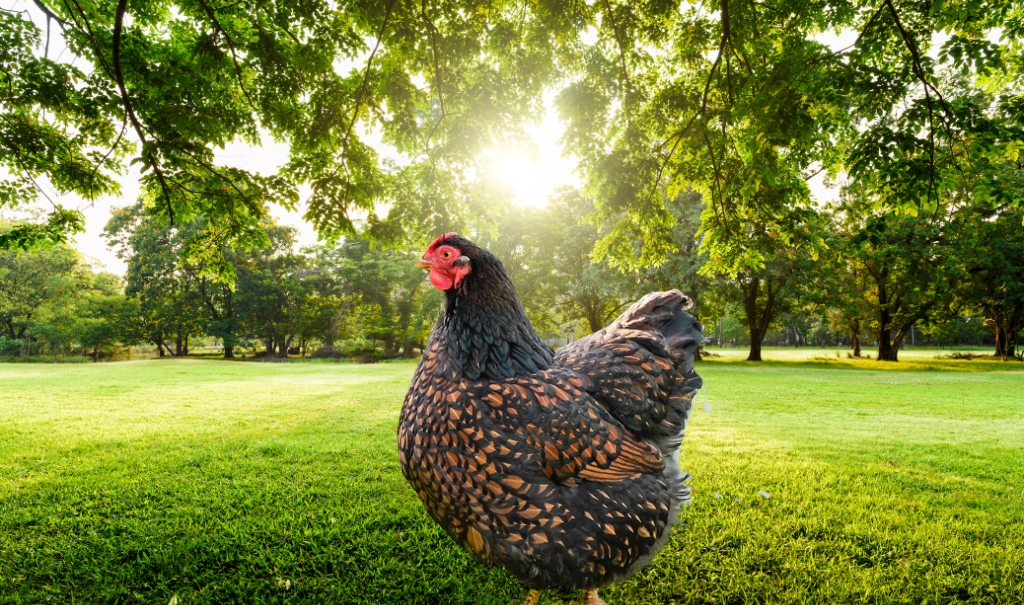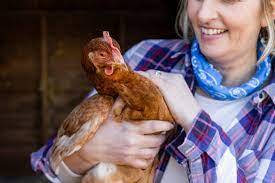The Wyandotte chicken is a beautiful and adaptable breed that is known for having beautiful feathers, being friendly, and producing a lot of eggs. Wyandottes are from North America and are great at laying eggs and making meat. This makes them a great choice for backyard flocks and small-scale farms that want a bird that looks good and works well.

Origin and History
The Wyandotte chicken came to North America in the heart of the 1800s. During the 1870s and 1880s, mixing the Sebright, Cochin, and Brahma breeds created the new breed.
The adoption of the name “Wyandotte” is owed to the fact that early Wyandottes grew up in the Wyandotte region of both Wisconsin and New York. The moniker ‘American Sebrights’ or ‘Wyandotte Sebrights’ was how they started. The APA acknowledged the Wyandotte in 1883. This breed was one of the first to gain APA recognition when built in the United States.
The breed found quick fame because it was pretty, produced good eggs, and got along well with people. Wyandottes had multiplied throughout the US and Canada by the early 1900s and became a typical breed of chicken in the United States.
Right now, poultry lovers find the Wyandotte a favored choice. They receive admiration for their gorgeous looks, their friendly demeanors, and their skill at laying a huge number of eggs.
Characteristics
Wyandotte chickens are a beautiful breed known for having varied and detailed feather patterns. The roosters weigh between 3.5 and 4 kg, and the hens weigh between 2.7 and 3.2 kg. They are hardy and can grow in a wide range of temperatures. Wyandottes are a good choice for many people who like chickens because they are busy foragers and don’t need to be fed often. Their feathers are tight and fluffy, so they need to be brushed often. Their combs and wattles are about average size.
Temperament And Behavior
People like these chickens because they are calm and nice. They aren’t too mean, which makes them great for backyard flocks where they might have to live with other chicken types. Because they are calm, they are also easy to handle, even for newbies.
Wyandotte Chicken Care
Housing Requirements
Even though Wyandottes are tough birds, they still need the right home to do well. A coop with good airflow and lots of room is necessary. Not enough room in the coop for each bird can cause stress and health problems. Each bird should have at least 4 square feet of space.
Diet and Nutrition
Wyandottes need to eat a varied diet to stay healthy. You should give them high-quality layer feed along with fresh veggies, grains, and protein sources like mealworms. It should always be possible to get fresh, clean water.
Health Considerations
Chickens, in general, are healthy, but Wyandottes can get Marek’s disease and respiratory problems, just like any other chicken. The most common health problems can be avoided by getting regular checkups and shots and living in a clean space.

How many eggs do Wyandotte hens lay?
Wyandotte hens lay between 150 and 200 large brown eggs a year, a modest to high egg production. Usually, they start laying eggs between 18 and 20 weeks old and reach their peak in the first two years. Average annual egg production:
- Year 1: 200-220 eggs
- Year 2: 180-200 eggs
- Year 3: 150-180 eggs
Egg size and production may vary depending on nutrition, health, and management practices.
Meat Production
Wyandottes produce gorgeous eggs, yet they are also much sought after as game birds. The large and plentiful size of their bodies enables them to produce ample meat, making them apt choices for those wanting a breed that can accomplish more than one task. The renowned taste and texture of Wyandotte meat is well known. The birds are at exactly the correct fatty, soft, and tasty.
What are the types of Wyandotte Chickens?
There are several recognized varieties of Wyandotte chickens, differing in their plumage colors and patterns:
- Golden Laced Wyandotte: introduced in 1888
- Silver Laced Wyandotte: Introduced in 1883
- Blue Wyandotte: Introduced in 1977
- Black Wyandotte: Introduced in 1893
- White Wyandotte: Introduced in 1888
- Buff Wyandotte: Introduced in 1893
- Columbian Wyandotte: Introduced in 1905
The American Poultry Association (APA) recognizes these eight varieties.
Each variety retains the breed’s friendly, outgoing personality and productive egg-laying abilities.
Are Wyandotte Chickens broody?
Wyandotte chickens are known to get broody from time to time, but they don’t usually sit on eggs and hatch them. There is a strong urge in them to raise chicks, but it’s not as strong as in some other breeds. Wyandottes usually go back to laying eggs after being broody if they are cared for properly.
Are Wyandotte hens good mothers?
Wyandotte hens are loving and caring moms, but they don’t always stay brooding. When they are broody, they work hard to take care of their chicks and protect them. However, they are more likely than other types to leave their nests or stop having babies, so they need to be watched more closely.

Pros and Cons of Wyandotte Chickens
Pros:
- Nature that is friendly, calm, and easygoing
- Beautiful, complicated feathers
- 150 to 200 eggs per year is a good number.
- Hardy and able to handle different weather
- Active hunters and not very good eaters
Cons:
- Low broodiness and maternal instincts
- High-maintenance feathers requiring regular grooming
How do they adapt to winter?
Wyandotte chickens are very tough and can survive in cold winters. They can survive in temperatures as low as 0°F (-18°C) thanks to their thick, fluffy feathers and dense bodies. They don’t need much special care, but it is important to give them a safe place to live, make sure it has good airflow, and make sure they can get fresh water and food.
What are the health problems of Wyandotte chickens?
These chickens are usually healthy, but they can get certain health problems:
Due to their large size, Wyandottes can have heart problems. Their tight, feathered bodies can also cause lung problems. Common problems like obesity, frostbite, mites, lice, and bumblefoot can be avoided or managed with regular checks.
Final Thought
Wyandotte chickens are a hardy breed that can do a lot of different things. They are great for both small-scale backyard farmers and bigger poultry operations. The Wyandotte is a breed that you should think about if you want to get eggs, meat, or just add some beauty to your group. They are great for chicken keepers of all kinds because they are easy to care for, friendly, and can handle cold weather.
FAQs
What Makes Wyandotte Chickens Unique?
Wyandottes are unique for their dual-purpose functionality, beautiful feather patterns, and ability to adapt to cold weather.
How Long Do Wyandotte Chickens Live?
On average, Wyandottes live between 6 to 12 years, though they can live even longer with proper care.
Are Wyandotte Chickens Good for Beginners?
Yes, Wyandottes are a great choice for beginners due to their friendly temperament and ease of care.
How Do Wyandotte Chickens Handle Heat?
Wyandottes can tolerate heat, but they need plenty of shade and water in hot weather to stay comfortable.
What Is the Best Diet for Wyandotte Chickens?
A balanced diet of high-quality layer feed, grains, fresh greens, and occasional protein treats like mealworms will keep your Wyandottes healthy.


